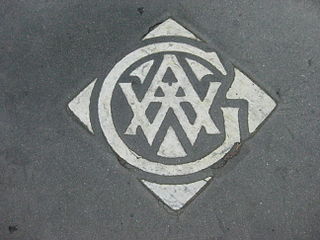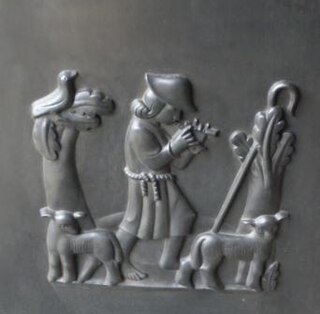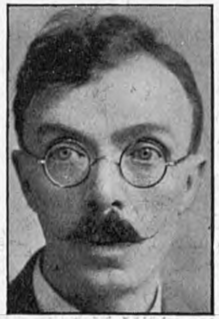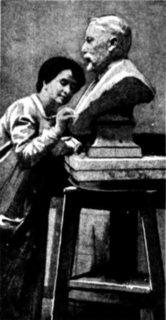Related Research Articles

The Art Workers' Guild is an organisation established in 1884 by a group of British painters, sculptors, architects, and designers associated with the ideas of William Morris and the Arts and Crafts movement. The guild promoted the 'unity of all the arts', denying the distinction between fine and applied art. It opposed the professionalisation of architecture – which was promoted by the Royal Institute of British Architects at this time – in the belief that this would inhibit design. In his 1998 book, Introduction to Victorian Style, University of Brighton's David Crowley stated the guild was "the conscientious core of the Arts and Crafts Movement".

Édouard Lantéri was a French-born British sculptor and medallist whose romantic French style of sculpting was seen as influential among exponents of New Sculpture. His name is also frequently spelled without accents as Edouard Lanteri and his first name sometimes given in its English form as Edward.
Charles John Allen was a British sculptor, and a figure in the New Sculpture movement.

Walter Marsden (1882–1969) was an English sculptor born in Lancashire. He saw active service in the First World War and was awarded the Military Cross. After the war, like many other sculptors who were also ex-servicemen, he carried out sculptural work on war memorials. Most of these were erected in Lancashire.

Vernon Hill (1887–1972), born in Halifax, Yorkshire, England, was a sculptor, lithographer, illustrator and draughtsman.

Radnor Walk is a residential street in the Royal Borough of Kensington & Chelsea off the King's Road in London. The houses are mid and late Victorian and the street is part of the Royal Hospital Conservation Area. It was originally called Radnor Street, and was named after John Robartes, 1st Earl of Radnor who died in Chelsea in 1685. It was renamed Radnor Walk in 1937.
Trafalgar Studios were a set of purpose-built artists' studios on in Manresa Road in the Chelsea area of London, England, just off the King's Road. A number or notable artists worked there.
Henry Hampton was an English sculptor, creator of public memorials and artist who was active between 1888 and 1927.

Charles Leighfield Jonah Doman FRBS was a sculptor from Nottingham.
Christabel Dennison (1884-1924) was a British artist, known for her paintings and sculptures.
Pauline Aitken was a British artist and sculptor.
Pauline Boumphrey was an American sculptor who spent the majority of her career working in Britain.
Irene Mary F.C. Browne was a British artist known for her sculptures and pottery.
Agnes Freda Forres, Baroness Forres was a British artist known for her sculpture work in bronze and plaster.
The Parlanti Foundry was an art bronze foundry located at the Albion Works, 59 Parsons Green Lane in Parsons Green, London, and was in operation from 1895 until 1917.

Eva Ellenor Benson was an Australian sculptor who produced portrait studies, figure works and medallions. Benson spent part of her career working in Britain.
Phyllis Muriel Cowan Archibald, later Phyllis Archibald Clay, was a British sculptor. Archibald was an Associate member of the Royal Society of British Sculptors from 1923, and member of the Glasgow Society of Lady Artists.
M. Lilian Simpson (c.1871–1897) was a British sculptor.
Helen Victoria Mackay was a British sculptor.
References
- 1 2 3 The Society of Arts (1863). From November 21, 1862, to November 13 1863. The journal of the Society of Arts and of the Institutions in Union. XI. London: Bell and Daldy. p. 627. Retrieved 23 January 2020.
- 1 2 Carteret-Bisson, Frederick Shirley Dumaresq de (1884). For Girls. Our schools and colleges. II. London: Simpkin, Marshall & Co. p. 300. Retrieved 20 January 2020.
- 1 2 "West London School of Art". Mapping the Practice and Profession of Sculpture in Britain and Ireland 1851-1951. Glasgow: University of Glasgow History of Art and HATII. 2011. Retrieved 19 January 2020.
- ↑ Godwin, George, ed. (30 March 1867). "The West London School of Art". The Builder. London: Wyman and Sons. p. 222. Retrieved 23 January 2020.
- 1 2 The Building news and engineering journal: January to June 1880. 38. London: E. J. Kibblewhite. 1880. pp. 117 & 129. Retrieved 20 January 2020.
- ↑ Walford, Edward (1873). Westminster and the west suburbs. Old and new London : a narrative of its history, its people, and its places. IV. London: Cassell, Petter, & Galpin. p. 457. Retrieved 20 January 2020.
- ↑ Hall, W. G. (1966). "Sunderland school of Science and Art, 1869–1902". The Vocational Aspect of Secondary and Further Education. 18 (41): 164–180. doi: 10.1080/03057876680000181 . ISSN 0305-7879.
- ↑ An Old Colonist (9 November 1889). "A trip to Europe". The Queenslander . Brisbane. p. 886. Retrieved 19 January 2020.
- 1 2 Eighth annual report of the commissioner of labor, 1892: Industrial education. Washington, USA: Government Printing Office. 1893. p. 400. Retrieved 21 January 2020.
- ↑ "Polytechnic School of Art, Regent Street". Mapping the Practice and Profession of Sculpture in Britain and Ireland 1851-1951. Glasgow: University of Glasgow History of Art and HATII. 2011. Retrieved 19 January 2020.
- ↑ Pycroft, George (1881). Art in Devonshire : with the biographies of artists born in that county. London: Hamilton Adams & Co. p. 13. Retrieved 14 July 2021.
- ↑ Fink, Theodore (21 June 1941). "Julian Ashton's story of his life". The Herald. Melbourne. p. 16. Retrieved 18 January 2020.
- ↑ "Depicter of cats". The West Australian . Perth. 7 July 1939. p. 18. Retrieved 19 January 2020.
- ↑ Basil Hunnisett, Engraved on Steel: History of Picture Production Using Steel Plates (2018), p. 37
- ↑ Dugan, Sally (15 April 2016). Baroness Orczy's The Scarlet Pimpernel: A Publishing History. Routledge. p. 40. ISBN 978-1-317-17617-6.
- ↑ "Orczy, Emmuska (1865-1947) Baroness Orczy, Novelist". discovery.nationalarchives.gov.uk. Retrieved 28 February 2021.
- ↑ Hiller, Geoffrey G.; Groves, Peter L.; Dilnot, Alan F., eds. (2019). An Anthology of London in Literature, 1558-1914. Springer. p. 229. ISBN 9783030056094.